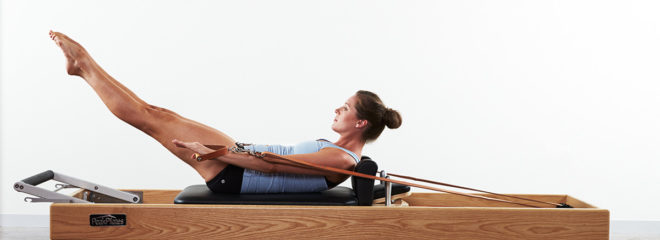By Colleen Glenn
Years ago when we started Peak Pilates® education, the development team debated over the use of the terms neutral pelvis and neutral spine and how they were addressed and delivered in our educational programs. Many organizations, using scientifically and physical therapy based research, used these terms to define their approach to Pilates. This is still true today. Participants who studied under these different schools raised many questions. As trainers in the field, the right verbiage and educational acumen was necessary to address concerns professionally. More important to the team, was authenticity in delivering and living the Peak Pilates philosophies.
Several years ago, these issues were addressed thoroughly, at a trainer intensive in Plum Island. Breakout groups conducted role playing scenarios around this topic and proved this method could be an effective teaching tool. Consistency and repetition are invaluable for learning, so we have once again decided to delve into this topic. Neutral pelvis and neural spine are often mistakenly interchanged. However, they are two separate positions; let’s take a look at the pelvis first. Neutral Pelvis is defined as having the anterior superior iliac spine in the same coronal plane as the pubic symphysis. The pelvis should not be too arched (anterior tilt) or too tucked (posterior tilt). Bone structures differ from individual to individual so this definition is a general rule of thumb.
What’s the big deal about neutral pelvis? It is important to note neutral pelvis as a reference point for the teacher in analyzing movement and posture. It can be found by touch techniques and visual observations during teaching. Using the Fundamental Clock work is effective. It is not something we teach in order for students to commence exercising, rather a position to move in and out of functionally. We call this the optimal pelvic position. It’s an important position during certain exercises, for example during side splits. In many cases individuals cannot keep or find a neutral pelvis, they don’t have the awareness to do so and when they try, can create back pain. In therapy sessions, neutral pelvis may be taught for specific reasons under the care of a licensed professional. Because the movements of the pelvis affect the spine it is important to understand their integral relationship. A neutral pelvic position does not necessarily mean one has a neutral spine.
So what is the neutral spine? Neutral Spine is the natural curves of the spine through the cervical to lumbar regions. Individuals will differ due to normal anatomical deviations. What’s the importance? The goal of Pilates is for the spine to become more neutral and aligned in a given session and throughout time. It is not necessarily the goal of supine and prone exercises to work in a neutral spine position, however, when lying in the supine position, the curves are naturally reduced due to the force of gravity. Peak Pilates understands and advocates a neutral functional spine up right against gravity as the result of moving the spine fully in all planes throughout a session. In therapeutic settings with licensed professionals neutral spine, with supine and prone exercises, may be the goal. In the Pilates movement system the spine moves in and out of its natural curves with strength, grace and control. Neutral spine is simply one position. It is not functional to hold it for extended periods of time and if one tries they may create undue tension and rigidity. Certainly when enjoying a nice dinner keep your spine upright and aligned, but don’t be like a statue! Belly to the backbone Drawing the abs in and up to lengthen and make contact with the mat is completely different then pushing the back into the mat. The latter is incorrectly executed by either pushing the abs out and/or tucking the pelvis under, which shortens the distance between the sternum and pubic bone. This is where criticism of classical Pilates comes from. Many people do not understand that pushing the spine to the mat that way is not advocated in classical Pilates. Make sure to guide teachers in axial elongation from their Powerhouse, teach them the difference between correct and incorrect positioning so they too are armed with good information. Neutral spine and pelvis may be natural positions but they are not the best possible positions for every exercise.
When doing Pilates, one should focus on multi-planar movements. You should be prepared to answer the following questions about neutral pelvis and spine. Why don’t you work in a neutral spine? What about a neutral pelvis, isn’t that important too? If you are not able to field these questions, contact your regional representative and discuss these terms for further clarification. Gear your teachers into the concept of a moving, thinking and intelligent body. Bodies that have an aligned spine and a functional pelvis remain healthy.
For more instructor tips, subscribe to our newsletter!



